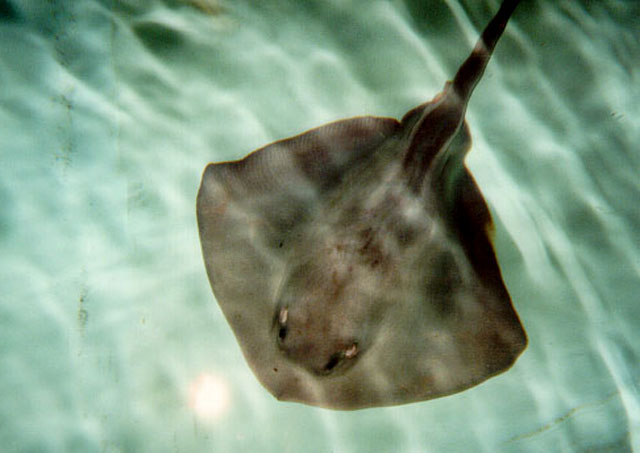| Dasyatidae (Stingrays), subfamily: Dasyatinae |
| 96 cm WD (male/unsexed) |
|
pelagic-oceanic; marine; depth range 1 - 381 m |
| Probably cosmopolitan in tropical and subtropical seas. Eastern Pacific: Reported from Vancouver (Ref. 11980), from California (USA), Baja California (Mexico) to Chile, and the Galapagos Is. (Ref. 9068). Western Atlantic (Ref. 7251). Eastern Atlantic: Southeastern coasts of the Mediterranean and off Sicily; Reported from Cape Verde (Ref. 34514). Indian Ocean. |
|
A thick, dark stingray with a broadly rounded snout and an angular pectoral disc; tail less than twice body length with a long lower caudal finfold ending far in front of tail tip, but with no upper finfold; disc without thorns; usually 1 extremely long sting on tail; eyes do not protrude (Ref. 5578). Uniformly violet, purple, or dark blue-green dorsally and ventrally (Ref. 3263). No prominent markings (Ref. 3263). |
| Found in open, tropical and warm temperate waters usually in the first 100 m. Possibly the only totally pelagic member of the family (Ref. 6871). Feeds on coelenterates (including medusae), squid, decapod crustaceans, and fish. Ovoviviparous (Ref. 50449). Venomous spine on tail. Common catch of the pelagic tuna (and shark) longline and gillnet fisheries (drift, Ref. 75025) operating throughout the region (Ref. 58048); also by purse-seine and bottom trawls (Ref. 75025). Utilized for its meat and sometimes cartilage (Ref.58048). Total length 110 TL (80 cm WD) (Ref. 9254). |
|
Least Concern (LC); Date assessed: 09 November 2018 Ref. (130435)
|
| venomous |
Source and more info: www.fishbase.org. For personal, classroom, and other internal use only. Not for publication.

